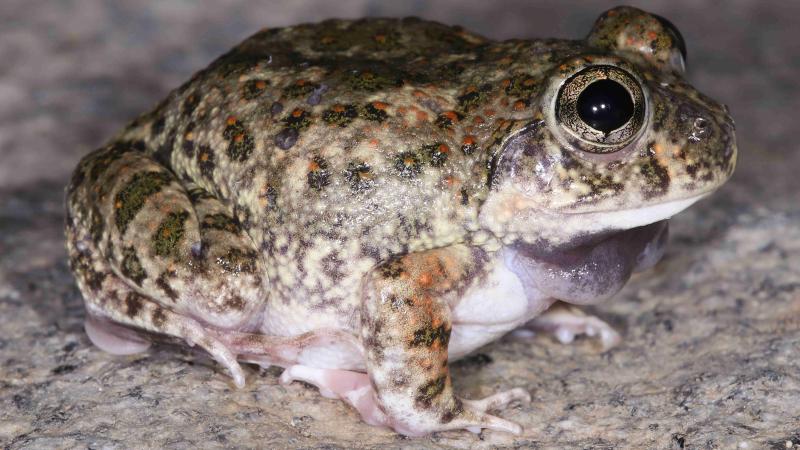
When we learn about the discovery of a new species, we immediately assume that it must have been found in a forest, a biodiversity hotspot, or a remote area far from human settlement. However, what if the newfound species is actually identified right in the heart of a densely populated region within a sprawling city?
Researchers from national and international institutions have discovered a new frog species in urban Bengaluru. The burrowing frog species, belonging to the genus Sphaerotheca is named varshaabhu, which takes its name from the Sanskrit words, varsha, meaning rain, and bhu, meaning taking birth. This name is attributed to its behaviour of coming out of its burrows during early monsoon showers to breed and continue its life cycle. This species will be commonly called the Varsha burrowing frog.
Dr. Deepak P, Assistant Professor, Mount Carmel College Autonomous, the lead researcher, expressed joy and excitement about the discovery and shared,
“This discovery challenges our preconceptions about where new species can be found. The fact that such a unique frog has been living right under our noses in the heart of Bengaluru is truly remarkable.”
This species was discovered in Budumanahalli an agro-horticultural region near Rajanukunte in sprawling North Bengaluru. Dr. Deepak, accidentally came across this new species while conducting a routine amphibian survey in the urban areas of Bengaluru. Initial observations showed the possibility of this being a new species, and morphological and advanced genetic analyses confirmed the same. This study is published in the international peer-reviewed journal, Zootaxa.
This discovery is an outcome of multi-institutional collaborations involving Mount Carmel College, Autonomous, Bengaluru; Zoological Survey of India (ZSI), Western Regional Centre (WRC), Pune; JAIN (Deemed- to- be-University), Bengaluru; Institute of Systematics, Evolution, Biodiversity (ISYEB), National Museum of Natural History, CNRS, Sorbonne University, Paris, France; Centre for Ecological Sciences (CES), Indian Institute of Science, Bengaluru; Laboratory of Animal Behaviour and Conservation, College of Biology and the Environment, Nanjing Forestry University, Jiangsu, China and Genetics Research Laboratory, Department of Zoology, Yuvaraja College, University of Mysore, Mysore.
It is interesting to note that the urban wildlife too are getting accustomed to city life, and are evolving themselves to be a part of these concrete jungles. They display interesting behaviours suggesting that these species are adapting themselves to navigate through rapid urbanisation. This discovery is an important milestone in urban biodiversity research and highlights the resilience of wildlife in urban ecosystems.
Cities that once supported a limited variety of frog species are transforming into inhospitable environments for their thriving. Instead, what prevails are rapidly expanding concrete jungles, spreading like wildfire. Bengaluru, known as the Garden City of India, is witnessing a swift decline in its green cover, leading to a diminishing frog population. As these amphibians are highly responsive to their surroundings, their presence is crucial for ecosystems, serving as vital bioindicators. The peri-urban areas, primarily characterised by agricultural landscapes, are gradually assimilating into the main city, experiencing a surge in human habitation.
“Researchers are still clueless on the role of urban and peri-urban green locales supporting biodiversity but the current research gives us insight and hope on how larger spaces and water bodies could be conserving the species in an urban context,” says Dr.Chetan Nag K.S, Associate Professor from CUBEC, Jain University.
It can be recalled that another species of burrowing frog, Spherotheca bengaluru was discovered in the year 2020 from a degraded urban ecosystem in Bengaluru. Hence, it may be possible that this species was overlooked as an already known species, given that the new species’ physical appearance and calls were seemingly similar to that of the Bengaluru burrowing frog.
Along with the morphological and advanced genetic analyses, bioacoustics (study of sounds of living organisms), has played a significant role in showing the distinctiveness of the newly discovered species.
“The discovery of the new burrowing frog species in Bengaluru city emphasises the indispensable role of bioacoustics in delineating the cryptic characteristics of Sphaerotheca varshaabhu through its vocalisation (calls), highlighting the profound significance of bioacoustics in modern amphibian taxonomy. This technique should become a regular practice in amphibian taxonomy,” says Vishal Kumar Prasad Ph.D scholar at Laboratory of Animal Behaviour and Conservation, College of Biology and the Environment, Nanjing Forestry University, Jiangsu, China and Secretariat Member IUCN-SSC Amphibian specialist group.
This discovery indicates the existence of additional undiscovered frog species, potentially contributing significantly to the biodiversity tally in any particular area. With a growing community of amphibian researchers, one can anticipate further species discoveries in the future. This underscores the necessity for effective conservation efforts for the newly identified species. The team intends to partner with local environmental authorities to implement conservation measures safeguarding the newfound frog species and its habitat.
“We hope that this discovery prompts increased attention to the importance of urban biodiversity conservation, specifically the permanent water bodies in the human habited landscapes,” added Dr. K.P Dinesh, Scientist E, at the Zoological Survey of India.






